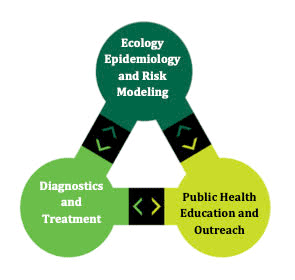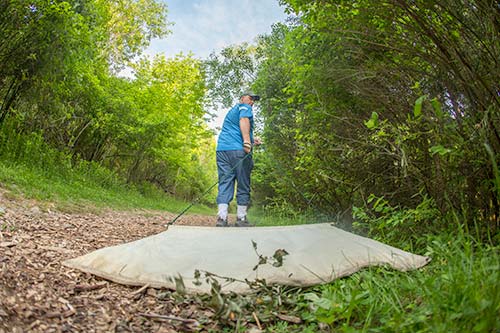
Tick-Borne Disease Research Center: A Trans-disciplinary Research Center for Lyme and Other Tick-borne Diseases
The Center consolidates and coordinates Lyme and other tick-borne disease research at Binghamton University in an integrative, interdisciplinary, transformative National Research Center. There are three main Pillars of the Center that collaborating faculty, physicians, and researchers are implementing:
Research Pillars of the Center
Pillar I: Ecology, Epidemiology and Risk Modeling: Host-vector and pathogen interactions and integrative models of disease transmission and spread.
Pillar II: Diagnostics and Treatment: New diagnostic tools for both acute and chronic Lyme disease and development of new treatment regimes.
Pillar III: Public Health: Mitigation strategies and policy changes working with County Health Departments to enhance the public’s health; Education: Primary and secondary school teacher and K-12 student education and University training of the next generation of researchers; Outreach: Community education through our annual Lyme Disease Conference and community workshops and lectures.
The Center’s outreach includes regional and national patient communities, foundations, and medical health professionals. In keeping with the increasing interdisciplinary nature of the University, the Center’s core faculty cuts across four diverse colleges and schools: Harpur College of Arts and Sciences (including Anthropology’s Ralph Garruto), the School of Pharmacy and Pharmaceutical Sciences, the Thomas J. Watson College of Engineering and Applied Science, and the School of Nursing. The Center also includes collaborations with faculty from SUNY Upstate Medical University, SUNY Broome, SUNY Delhi, and SUNY College of Environmental Science and Forestry and with physicians at United Health Services (UHS) hospitals and clinics (28 sites) throughout New York.
Faculty and students involved in Lyme disease research regularly accept community invitations to participate in educational programs on Lyme and other tick-borne illnesses in New York, New Jersey, and Pennsylvania. Such programs include educational events provided for local and regional K-12 schools and adult public educational programs through the New York State Master Teachers Program, regional Lyme support groups, and adult education programs (Lyceum).
The Center trains graduate students in the MPH program and the Graduate Program in Biomedical Anthropology. It provides research training of undergraduate students in our Freshman Research Immersion (FRI) program in Molecular and Biomedical Anthropology as well as the training of undergraduates throughout the University across all departments.
Risk of Lyme and Other Tick-Borne Diseases in Fragmented Ecospaces within Built Environments:
Ecological factors such as climate change, increasing tick and animal reservoir populations, fragmentation of ecological spaces, and expansion of suburban and peri-urban human populations is resulting in significant numbers of people coming in contact with tick populations carrying human pathogens. Currently, the Centers for Disease Control and Prevention estimates more than 330,000 new cases of Lyme disease annually with 95% of cases in the Northeast and Upper Midwest, among the most densely populated regions within the United States.
Urbanization has drastically altered physical landscapes. The rise of suburban and peri-urban spaces and associated infrastructure represents the built environment with numerous fragmented ecologies. Built environments contain high use parks, primary and secondary schools and college campuses, playgrounds and residential neighborhoods where the risk of transmission of vector-borne diseases is often high.
Our knowledge of the dynamic interaction between infected ticks, primary reservoir host populations and human secondary hosts in fragmented ecospaces within built environments is minimal. The lack of such knowledge leaves public health professionals at a disadvantage when addressing the emerging problem of tick-borne disease transmission. We are determining the density and infectivity of the primary competent reservoir host (Peromyscus leucopus) and the density and prevalence of infection in the tick vector (Ixodes scapularis), the transmitter of the Lyme infectious agent (Borrelia burgdorferi) and other tick-borne infections to humans and domestic animals in a six county area of the Southern Tier and Upper Susquehanna River Basin of New York. We are also identifying and quantifying key demographic and behavioral factors that place humans at risk of contract with these infectious agents.
This research contributes to an understanding of the ecological complexities governing the epidemiology and transmission of Lyme and other tick-borne illnesses within built environments and is producing new knowledge that is causing a re-examination of the risk of acquiring tick-borne diseases within settings often perceived as low risk.
Modeling Lyme Disease in Built Environments in the Northeastern US Using Ecological, Demographic, and Behavioral Risk Factors:
This project adopts a system dynamics approach to study the impact of behavioral and environmental factors on Lyme disease transmission and prevention by developing a simulation model of Lyme incidence using ecological, social and behavioral risk factors. We are also attempting to determine the most cost-effective prevention strategies using the models we develop. Our models are built by assessing tick density, tick infectivity, frequency of tick bites, vegetation factors, human behavioral risks, and current Lyme disease incidence in the six county region within the Upper Susquehanna River Basin, adjacent to the Hudson River Basin, which has the highest incidence of Lyme disease in the US.
Recent Publications
- Roome A, Spathis R, Hill L, Darcy J and Garruto RM. 2018. Lyme Disease Transmission Risk: Seasonal Variation in the Built Environment. Healthcare. 6(3), 84.
- Roome A, Hill L, Al-Feghali V, Murnock C, Goodsell J, Spathis R and Garruto RM. 2017. Impact of white-tailed deer on the spread of B. burgdorferi. Journal of Medical and Veterinary Entomology. DOI: 10.1111/mve.12191.
- Sharareh N, Behler RP, Roome AB, Shepherd J, Garruto RM and Sabounchi NS. 2019. Risk Factors of Lyme Disease: An Intersection of Environmental Ecology and Systems Science. Healthcare 7(2), 66.
- Sharareh, N, Sabounchi NS, Roome A, Spathis R, and Garruto, RM. 2017. Model-based risk assessment and public health analysis to prevent Lyme disease. Royal Society Open Science, 4(11), 170841.
